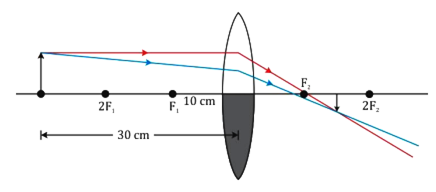One-half of a convex lens of focal length 10 cm is covered with a black paper. Can such a lens produce an image of a complete object placed at a distance of 30 cm from the lens? Draw a ray diagram to justify your answer.
A 4 cm tall object is placed perpendicular to its principal axis of a convex lens of focal length 20 cm. The distance of the object from the lens is 15 cm. Find the nature, position and the size of the image.
The convex lens will produce the complete image of the object even though half of the lens is covered. This is because the other half of the lens can refract the light coming from the object. However, the intensity of the image will be reduced.
Numerical:
Given,
Height of the object, h = 4 cm
Focal length of the convex lens, f = 20 cm
Object distance, u = -15 cm
Using the lens formula,
Therefore,
Thus, the image is formed 60 cm in front of the lens on the same side as that of the object.
Since v is negative, the image formed is virtual.
Using the formula for magnification of a lens,
That is,
h' = 
Since the height of the image is positive and greater than the height of the object, the image formed is erect and magnified.
Therefore, the image is virtual, erect and magnified.





